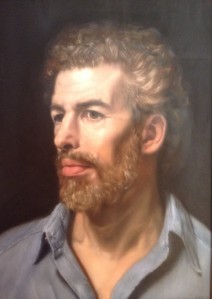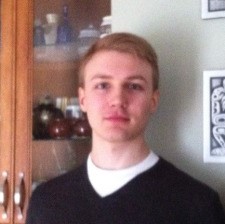Born to do Math 1 - Networks of Information Spaces
Scott Douglas Jacobsen & Rick Rosner
March 8, 2017
[Beginning of recorded material]
Scott Douglas Jacobsen: So you have a tattoo that says, “Born to do
Math,” as far as I know.
Rick Rosner: Yea, yea, I mean, it’s old. I got
it in like 1988, so it is not very legible anymore, but it’s still there.
S: You have a child prodigy history. You have an obsession of numbers.
You have a fear of some numbers, apparently. So there’s a deep intimate
connection in your life, personal and otherwise, with numbers, and therefore
with math and physics. So I want to start a new series called “Born to do
Math,” where we just pick a topic and talk about physics and math or we
research something beforehand and talk about that. You had an idea. Let’s talk
about that.
R: I was thinking about networks of
information spaces with an information space as an arrangement of information
within physics. Everyone has their own information space, just what they’re
thinking about from moment to moment. The connections among these information
spaces are simple and weak, very narrow-band. We can only share the information
from our information spaces with each other via speech.
I guess water colors, video, but we can’t link
information spaces. The links between us are very narrow-band. There’s nothing
like a true marriage of minds. So you’ve got these very relatively big
information spaces connected very weakly. It could look like the kids’ model of
a molecule with Styrofoam balls connected by Q-tips and all of the pretty
symbols. But that won’t be how it always is.
There’s a historical trend. It is not going to
end for broadband transmission of information. It hasn’t hit the contents of
our minds yet, but it will be looking at the way things are progressing.
Eventually, that will permit complicated connections among human information
spaces. Plus, we’ve got this AI future coming, where some people think there
will be a billion—not a billion, a trillion—information spaces.
S: You’re talking about Chris Cole’s extrapolation and theory.
R: Yea, I assume his thinking reflects a lot
of expert thinking. There’s going to be a mess of AI. Some will be trivial.
Some will be connected to humans, to turbo-charge human information processing.
Some of them will be massive on their own. They’ll be connected to each other
in increasingly complicated ways. Where you’ll be able to have something like
true marriages of minds, which will look in the geometry of information spaces,
like not simple.
Then you can look at the rest of the universe
with its 10^22 stars with an average of 1 planet per star. It is not
unreasonable to think there are a butt load of places where consciousness
originated and has been around a lot longer than we’ve been around. Those
places must have at least a bunch of globby connected spaces, not to mention
all of the other mathematically possible universe. You and I have talked about
a ladder of information spaces.
Where each information space has an armature,
a container, the hardware for each information space contained in a space
beyond the space, which implies a ladder of larger and larger information
spaces—but given the idea that they don’t have to be simply connected, what can
be simply imagined as a ladder—or more appropriately be imagined as a crazily,
bubbly, tangle of information processing entities.
S: With the active input, retrieval, and processing of information, in
an information based model of not only human computation but the universe
reflecting that, the physics of that, of an information space, will reflect
what we see in the universe in its physics. There’s a parallelism there.
R: Yea, I imagine—You and I, I think, imagine—the
active conscious center of an information space has physics looking similar to
what we look at when we look out into the universe, and that nodes where you’re
receiving information are likely centered on galaxies, centered on the center
of galaxies—where you have these black hole like structures with masses of a
million stars on up—could easily—not easily but could reasonably—be
hypothesized to be the pipelines where information goes in and out to other
linked sources of information, whether in the organism itself—with information
processing you’re not totally consciously aware of the processing sploots out
of the black holey thing and is processed by the arrangement of information
that is the galaxy surrounding the pipeline.
S: So what’s the summary statement?
R: Summary statement: we live in a world of
information spaces, where every man, woman is kind of an island with the island
being our information space or our consciousness, but in the future we will be
connected more complicatedly and intimately—and there’s a math for that. You
can imagine an information space model that kind of looks like a universe with
the connections being among, along, deep gravitational wells, where those wells
represent pipelines for information from other sources.
[End of recorded material]
Authors[1]

Rick Rosner
American Television Writer
RickRosner@Hotmail.Com
Rick Rosner

Scott Douglas Jacobsen
Editor-in-Chief, In-Sight Publishing
Scott.D.Jacobsen@Gmail.Com
In-Sight Publishing
Endnotes
[1] Four format points for the session article:- Bold text following “Scott Douglas Jacobsen:” or “Jacobsen:” is Scott Douglas Jacobsen & non-bold text following “Rick Rosner:” or “Rosner:” is Rick Rosner.
- Session article conducted, transcribed, edited, formatted, and published by Scott.
- Footnotes & in-text citations in the interview & references after the interview.
- This session article has been edited for clarity and readability.
- American Psychological Association. (2010). Citation Guide: APA. Retrieved from http://www.lib.sfu.ca/system/files/28281/APA6CitationGuideSFUv3.pdf.
- Humble, A. (n.d.). Guide to Transcribing. Retrieved from http://www.msvu.ca/site/media/msvu/Transcription%20Guide.pdf.
License
In-Sight Publishing and In-Sight: Independent Interview-Based Journal by Scott Douglas Jacobsen is licensed under a Creative Commons Attribution-NonCommercial-NoDerivatives 4.0 International License.
Based on a work at www.in-sightjournal.com and www.rickrosner.org.
Copyright
No comments:
Post a Comment